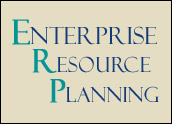
Growth in the enterprise resource planning market may have paused during the 2001-2002 recession, but it is now back to a steady pace, according to a new AMR Research report.
The consulting firm found that total ERP market revenue grew to more than US$25 billion in 2005due to strong customer demand, as well as a number of acquisitions of smaller niche vendors. It projects that the market will reach $29 billion this year — and that over the next five years, it will grow at an average of 10 percent.
SAP led the pack, with a 42 percent share of the industry’s revenues, despite Oracle’s acquisition of PeopleSoft. Oracle’s revenue share in 2005 was 20 percent, according to the report. Growing 12 percent and 110 percent respectively, these two vendors claimed the largest gains in the market. Manyof the smaller players stayed flat or even shrank. SAP and Oracle increased their combined market share to 65 percent of all new license sales.
Mature Market
These dynamics are not new to the ERP space, Jim Shepherd, senior vice president of research at AMRResearch, told CRM Buyer. “Growth over a long period of time — 20 years — hasbeen stable, registering 9-10 percent annually. The last half of the 90s was a big spike, and we saw real growthacceleration. Then, in the recession, growth rates dropped precipitously. What we are seeing now is a recovery.”
This is also a market where one or two vendors tend to dominate the top, followed far behind by a long tail of smaller vendors. “Who the largeplayers are does change over time, but the structure of the industry seems to stay the same,” Shepherd said.
He dismissed the notion that the ERP vendors ever completely saturated the market, stifling opportunities for new growth. “This is still a veryhealthy market. Vendors are expanding into new market segments, both in terms of vertical and client size as well as new geographies.”
Oracle vs. SAP
With an ERP business line that is twice the size of Oracle’s, there is little sign that SAP will be dislodged from its No. 1 position, Shepherd said. “Oracle spent billions of dollars to go from a quarter of the size of SAP to half of its size. I don’t know what they could buy to close that gap.” This is not to say Oracle’s acquisition spree was a waste of time. “In percentage gains, its growth was enormous.”
For its part, SAP is developing new go-to-market strategies to ensure that its position remains solid. A few months ago, for example, the company announced plans to roll out “enhancement packages” that would serve as interim upgrades between ,or in place of, the majorreleases. The enhancement packages will be introduced two to three times a year and are optional, Jeff Stiles, senior vice president for ERP solution marketing at SAP, told CRM Buyer. The first is expected this December.
“The point is to focus on those areas that represent market opportunities for SAP and those areas where customers are telling usthey want new functionality,” Stiles said. Those areas include human capital, account management, talent management,compensation, payment processes such as invoice to cash tracking, and industry-specific offerings.




















































